Management and Leadership: Analyzing Fast Food Consumption & Obesity
VerifiedAdded on 2021/09/14
|9
|2450
|46
Report
AI Summary
This report delves into the critical issue of child obesity, linking it to fast food consumption and the influence of advertising and marketing practices. The student attended a discussion forum by the Dietitians Association of Australia (DAA) and learned about the health implications of fast food, including the rise of childhood obesity, which can lead to severe health issues like diabetes and cardiac problems. The report emphasizes the need for strong management and leadership to raise public awareness and promote healthier eating habits, especially among children. It examines the impact of advertising on consumer behavior, the role of parents in guiding their children's food choices, and the need for policy interventions to limit fast food advertising targeting children. The report further analyzes the factors that contribute to child obesity, including advertisers' persuasive approaches and parental decisions influenced by disposable income and pester power. The student suggests solutions such as educational campaigns, responsible advertising, and parental guidance to promote balanced diets and address the issue of unhealthy fast food consumption. The report concludes by highlighting the roles of advertisers and parents in leading and managing their responses for children by developing approaches that involves educating them to interpret what things to buy and how often so that they can learn to balance under proper guidance.
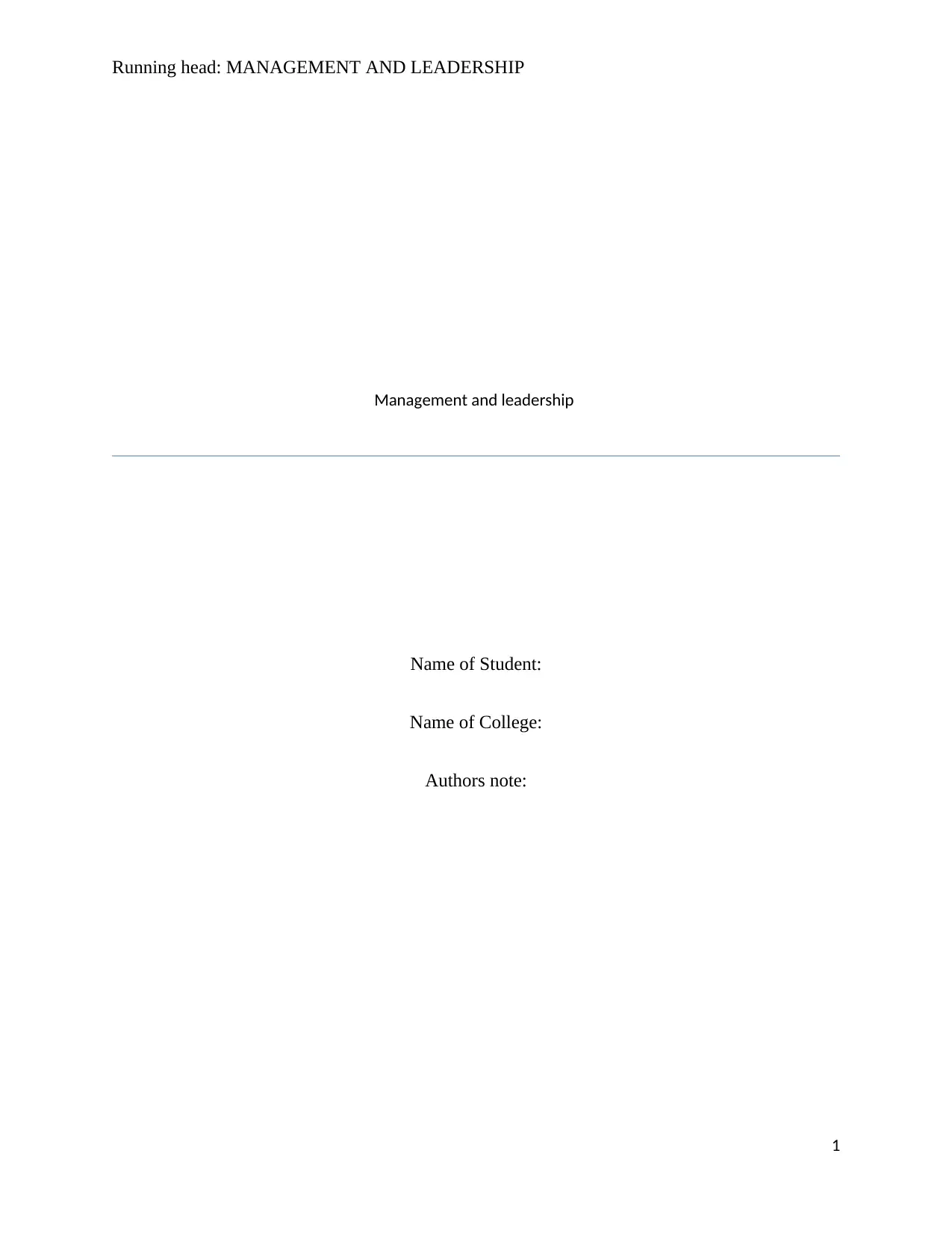
Running head: MANAGEMENT AND LEADERSHIP
Management and leadership
Name of Student:
Name of College:
Authors note:
1
Management and leadership
Name of Student:
Name of College:
Authors note:
1
Paraphrase This Document
Need a fresh take? Get an instant paraphrase of this document with our AI Paraphraser
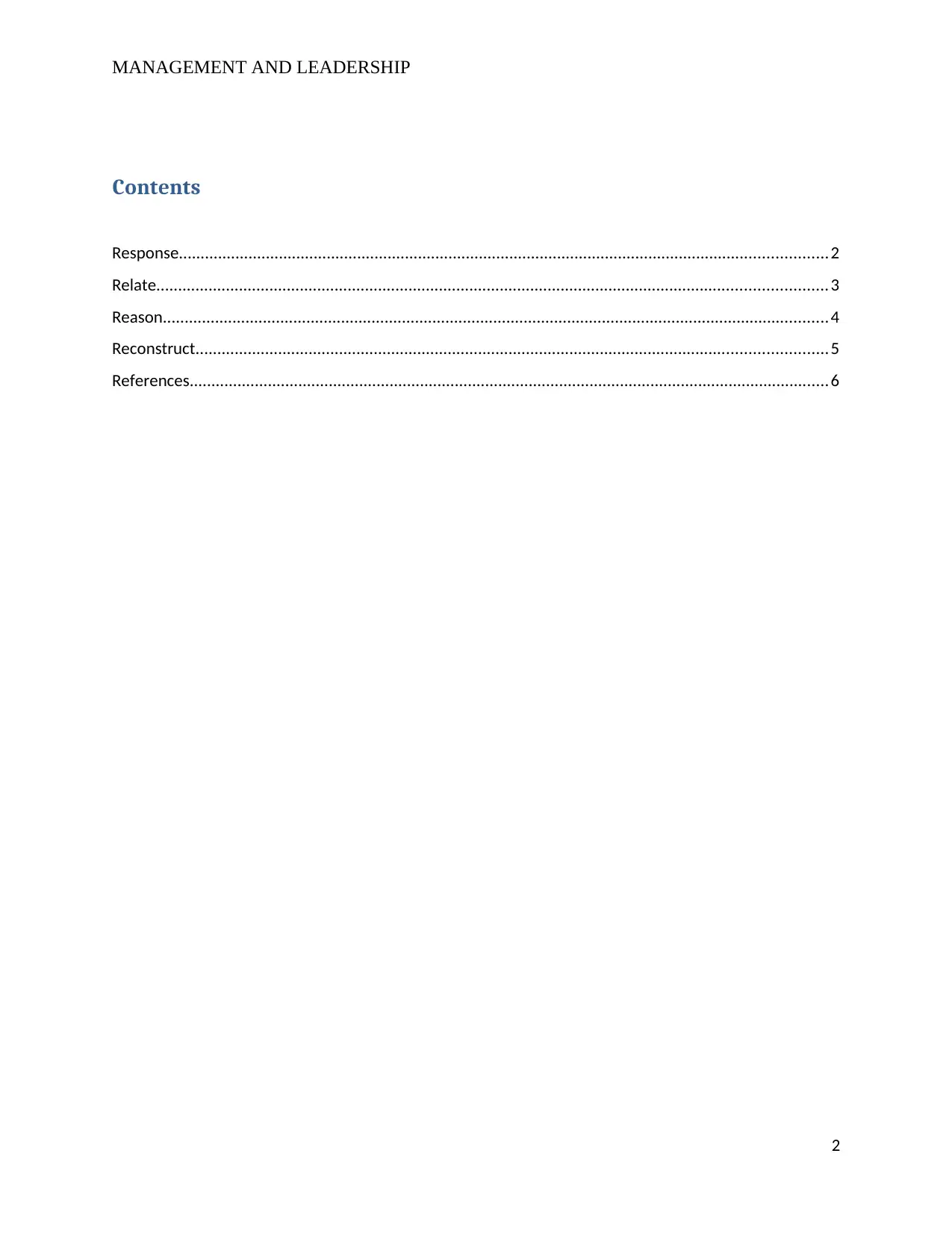
MANAGEMENT AND LEADERSHIP
Contents
Response.....................................................................................................................................................2
Relate..........................................................................................................................................................3
Reason.........................................................................................................................................................4
Reconstruct.................................................................................................................................................5
References...................................................................................................................................................6
2
Contents
Response.....................................................................................................................................................2
Relate..........................................................................................................................................................3
Reason.........................................................................................................................................................4
Reconstruct.................................................................................................................................................5
References...................................................................................................................................................6
2
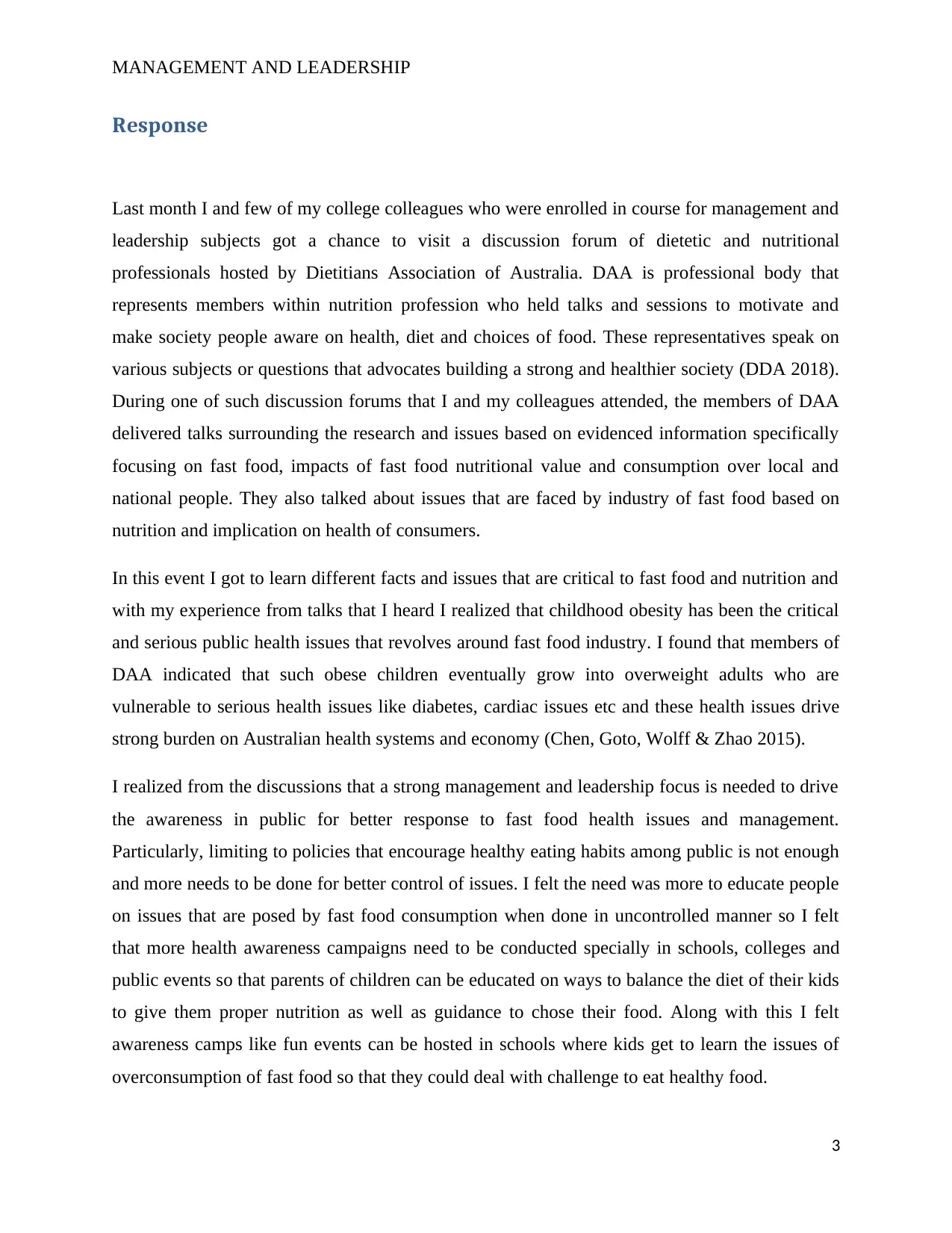
MANAGEMENT AND LEADERSHIP
Response
Last month I and few of my college colleagues who were enrolled in course for management and
leadership subjects got a chance to visit a discussion forum of dietetic and nutritional
professionals hosted by Dietitians Association of Australia. DAA is professional body that
represents members within nutrition profession who held talks and sessions to motivate and
make society people aware on health, diet and choices of food. These representatives speak on
various subjects or questions that advocates building a strong and healthier society (DDA 2018).
During one of such discussion forums that I and my colleagues attended, the members of DAA
delivered talks surrounding the research and issues based on evidenced information specifically
focusing on fast food, impacts of fast food nutritional value and consumption over local and
national people. They also talked about issues that are faced by industry of fast food based on
nutrition and implication on health of consumers.
In this event I got to learn different facts and issues that are critical to fast food and nutrition and
with my experience from talks that I heard I realized that childhood obesity has been the critical
and serious public health issues that revolves around fast food industry. I found that members of
DAA indicated that such obese children eventually grow into overweight adults who are
vulnerable to serious health issues like diabetes, cardiac issues etc and these health issues drive
strong burden on Australian health systems and economy (Chen, Goto, Wolff & Zhao 2015).
I realized from the discussions that a strong management and leadership focus is needed to drive
the awareness in public for better response to fast food health issues and management.
Particularly, limiting to policies that encourage healthy eating habits among public is not enough
and more needs to be done for better control of issues. I felt the need was more to educate people
on issues that are posed by fast food consumption when done in uncontrolled manner so I felt
that more health awareness campaigns need to be conducted specially in schools, colleges and
public events so that parents of children can be educated on ways to balance the diet of their kids
to give them proper nutrition as well as guidance to chose their food. Along with this I felt
awareness camps like fun events can be hosted in schools where kids get to learn the issues of
overconsumption of fast food so that they could deal with challenge to eat healthy food.
3
Response
Last month I and few of my college colleagues who were enrolled in course for management and
leadership subjects got a chance to visit a discussion forum of dietetic and nutritional
professionals hosted by Dietitians Association of Australia. DAA is professional body that
represents members within nutrition profession who held talks and sessions to motivate and
make society people aware on health, diet and choices of food. These representatives speak on
various subjects or questions that advocates building a strong and healthier society (DDA 2018).
During one of such discussion forums that I and my colleagues attended, the members of DAA
delivered talks surrounding the research and issues based on evidenced information specifically
focusing on fast food, impacts of fast food nutritional value and consumption over local and
national people. They also talked about issues that are faced by industry of fast food based on
nutrition and implication on health of consumers.
In this event I got to learn different facts and issues that are critical to fast food and nutrition and
with my experience from talks that I heard I realized that childhood obesity has been the critical
and serious public health issues that revolves around fast food industry. I found that members of
DAA indicated that such obese children eventually grow into overweight adults who are
vulnerable to serious health issues like diabetes, cardiac issues etc and these health issues drive
strong burden on Australian health systems and economy (Chen, Goto, Wolff & Zhao 2015).
I realized from the discussions that a strong management and leadership focus is needed to drive
the awareness in public for better response to fast food health issues and management.
Particularly, limiting to policies that encourage healthy eating habits among public is not enough
and more needs to be done for better control of issues. I felt the need was more to educate people
on issues that are posed by fast food consumption when done in uncontrolled manner so I felt
that more health awareness campaigns need to be conducted specially in schools, colleges and
public events so that parents of children can be educated on ways to balance the diet of their kids
to give them proper nutrition as well as guidance to chose their food. Along with this I felt
awareness camps like fun events can be hosted in schools where kids get to learn the issues of
overconsumption of fast food so that they could deal with challenge to eat healthy food.
3
⊘ This is a preview!⊘
Do you want full access?
Subscribe today to unlock all pages.

Trusted by 1+ million students worldwide
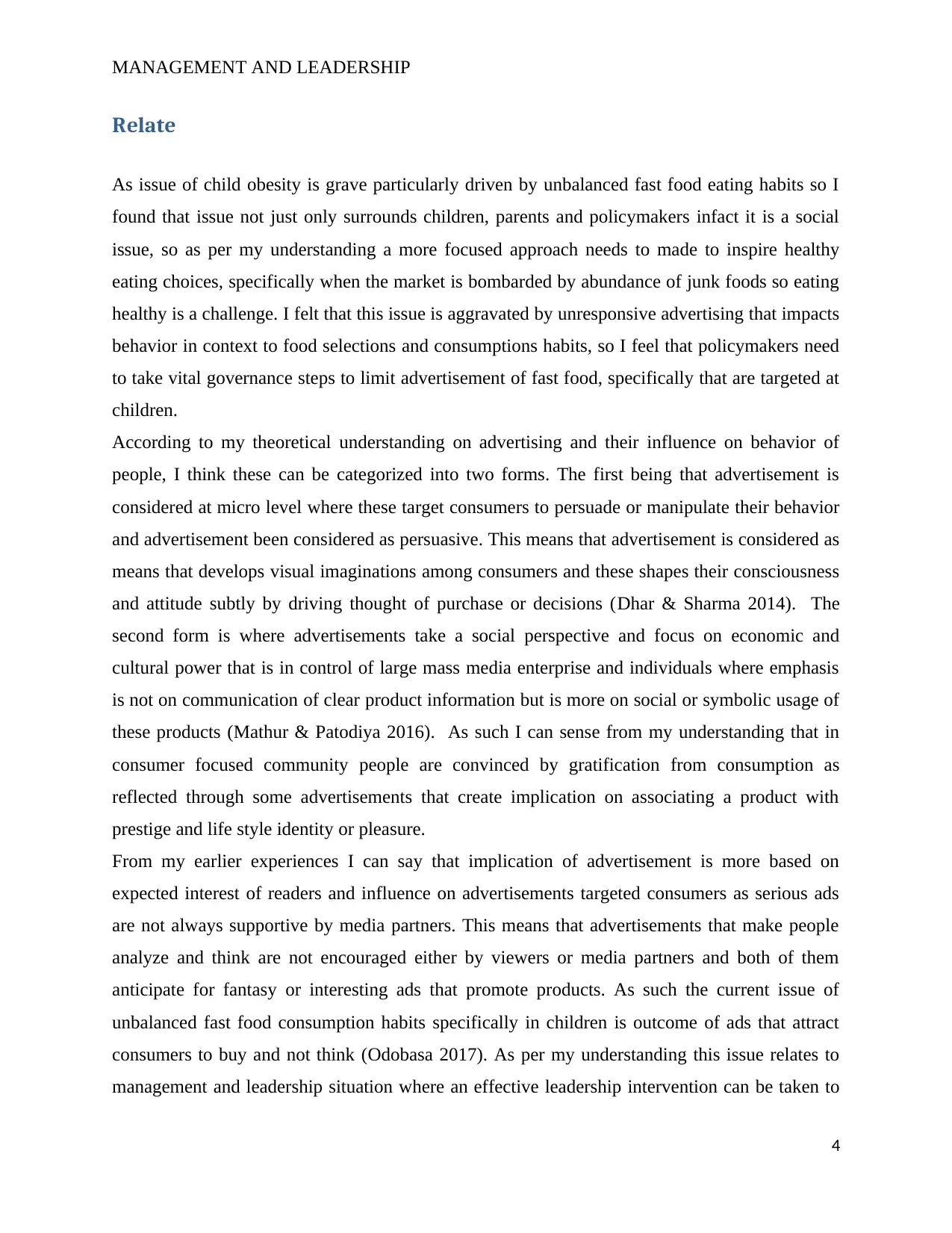
MANAGEMENT AND LEADERSHIP
Relate
As issue of child obesity is grave particularly driven by unbalanced fast food eating habits so I
found that issue not just only surrounds children, parents and policymakers infact it is a social
issue, so as per my understanding a more focused approach needs to made to inspire healthy
eating choices, specifically when the market is bombarded by abundance of junk foods so eating
healthy is a challenge. I felt that this issue is aggravated by unresponsive advertising that impacts
behavior in context to food selections and consumptions habits, so I feel that policymakers need
to take vital governance steps to limit advertisement of fast food, specifically that are targeted at
children.
According to my theoretical understanding on advertising and their influence on behavior of
people, I think these can be categorized into two forms. The first being that advertisement is
considered at micro level where these target consumers to persuade or manipulate their behavior
and advertisement been considered as persuasive. This means that advertisement is considered as
means that develops visual imaginations among consumers and these shapes their consciousness
and attitude subtly by driving thought of purchase or decisions (Dhar & Sharma 2014). The
second form is where advertisements take a social perspective and focus on economic and
cultural power that is in control of large mass media enterprise and individuals where emphasis
is not on communication of clear product information but is more on social or symbolic usage of
these products (Mathur & Patodiya 2016). As such I can sense from my understanding that in
consumer focused community people are convinced by gratification from consumption as
reflected through some advertisements that create implication on associating a product with
prestige and life style identity or pleasure.
From my earlier experiences I can say that implication of advertisement is more based on
expected interest of readers and influence on advertisements targeted consumers as serious ads
are not always supportive by media partners. This means that advertisements that make people
analyze and think are not encouraged either by viewers or media partners and both of them
anticipate for fantasy or interesting ads that promote products. As such the current issue of
unbalanced fast food consumption habits specifically in children is outcome of ads that attract
consumers to buy and not think (Odobasa 2017). As per my understanding this issue relates to
management and leadership situation where an effective leadership intervention can be taken to
4
Relate
As issue of child obesity is grave particularly driven by unbalanced fast food eating habits so I
found that issue not just only surrounds children, parents and policymakers infact it is a social
issue, so as per my understanding a more focused approach needs to made to inspire healthy
eating choices, specifically when the market is bombarded by abundance of junk foods so eating
healthy is a challenge. I felt that this issue is aggravated by unresponsive advertising that impacts
behavior in context to food selections and consumptions habits, so I feel that policymakers need
to take vital governance steps to limit advertisement of fast food, specifically that are targeted at
children.
According to my theoretical understanding on advertising and their influence on behavior of
people, I think these can be categorized into two forms. The first being that advertisement is
considered at micro level where these target consumers to persuade or manipulate their behavior
and advertisement been considered as persuasive. This means that advertisement is considered as
means that develops visual imaginations among consumers and these shapes their consciousness
and attitude subtly by driving thought of purchase or decisions (Dhar & Sharma 2014). The
second form is where advertisements take a social perspective and focus on economic and
cultural power that is in control of large mass media enterprise and individuals where emphasis
is not on communication of clear product information but is more on social or symbolic usage of
these products (Mathur & Patodiya 2016). As such I can sense from my understanding that in
consumer focused community people are convinced by gratification from consumption as
reflected through some advertisements that create implication on associating a product with
prestige and life style identity or pleasure.
From my earlier experiences I can say that implication of advertisement is more based on
expected interest of readers and influence on advertisements targeted consumers as serious ads
are not always supportive by media partners. This means that advertisements that make people
analyze and think are not encouraged either by viewers or media partners and both of them
anticipate for fantasy or interesting ads that promote products. As such the current issue of
unbalanced fast food consumption habits specifically in children is outcome of ads that attract
consumers to buy and not think (Odobasa 2017). As per my understanding this issue relates to
management and leadership situation where an effective leadership intervention can be taken to
4
Paraphrase This Document
Need a fresh take? Get an instant paraphrase of this document with our AI Paraphraser
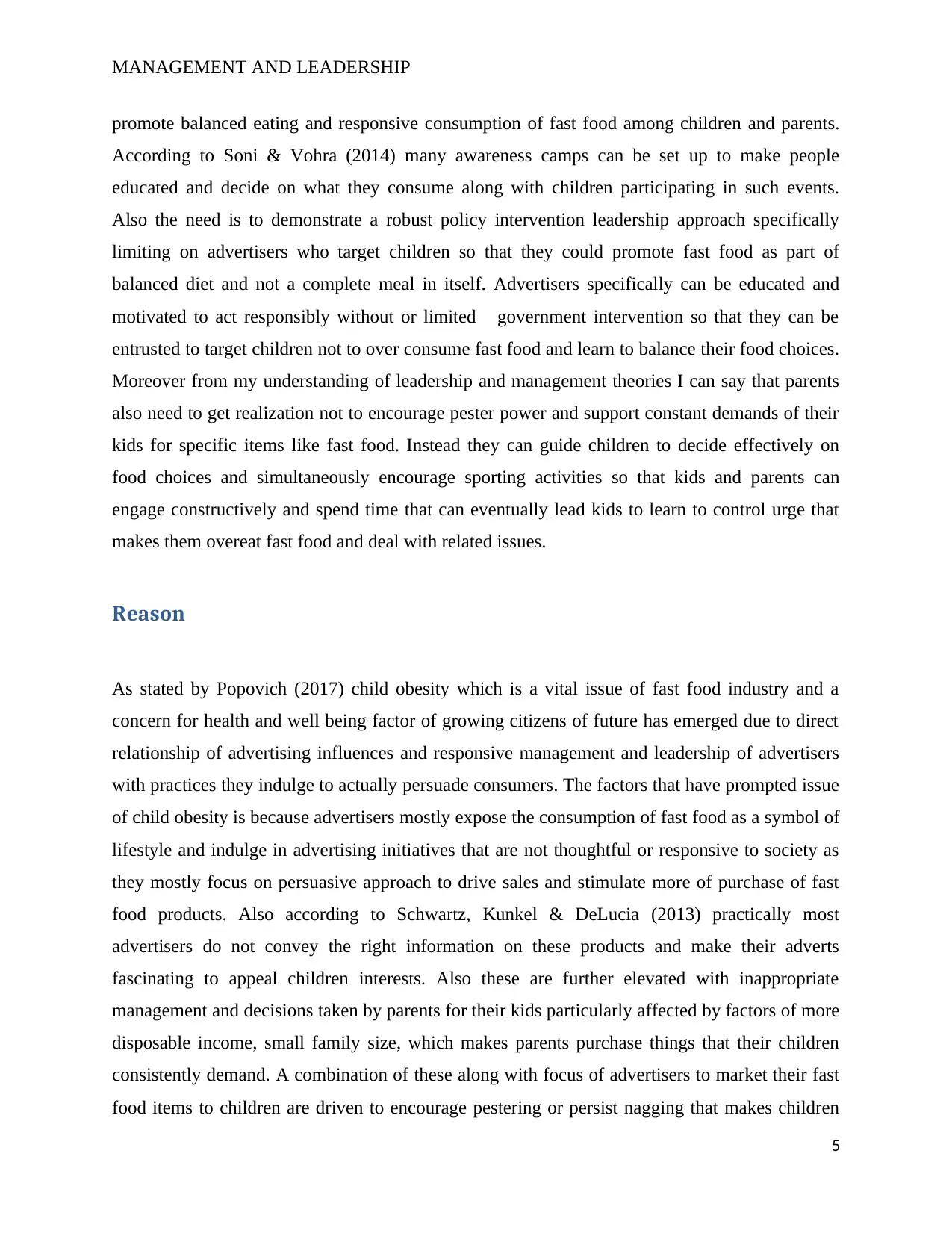
MANAGEMENT AND LEADERSHIP
promote balanced eating and responsive consumption of fast food among children and parents.
According to Soni & Vohra (2014) many awareness camps can be set up to make people
educated and decide on what they consume along with children participating in such events.
Also the need is to demonstrate a robust policy intervention leadership approach specifically
limiting on advertisers who target children so that they could promote fast food as part of
balanced diet and not a complete meal in itself. Advertisers specifically can be educated and
motivated to act responsibly without or limited government intervention so that they can be
entrusted to target children not to over consume fast food and learn to balance their food choices.
Moreover from my understanding of leadership and management theories I can say that parents
also need to get realization not to encourage pester power and support constant demands of their
kids for specific items like fast food. Instead they can guide children to decide effectively on
food choices and simultaneously encourage sporting activities so that kids and parents can
engage constructively and spend time that can eventually lead kids to learn to control urge that
makes them overeat fast food and deal with related issues.
Reason
As stated by Popovich (2017) child obesity which is a vital issue of fast food industry and a
concern for health and well being factor of growing citizens of future has emerged due to direct
relationship of advertising influences and responsive management and leadership of advertisers
with practices they indulge to actually persuade consumers. The factors that have prompted issue
of child obesity is because advertisers mostly expose the consumption of fast food as a symbol of
lifestyle and indulge in advertising initiatives that are not thoughtful or responsive to society as
they mostly focus on persuasive approach to drive sales and stimulate more of purchase of fast
food products. Also according to Schwartz, Kunkel & DeLucia (2013) practically most
advertisers do not convey the right information on these products and make their adverts
fascinating to appeal children interests. Also these are further elevated with inappropriate
management and decisions taken by parents for their kids particularly affected by factors of more
disposable income, small family size, which makes parents purchase things that their children
consistently demand. A combination of these along with focus of advertisers to market their fast
food items to children are driven to encourage pestering or persist nagging that makes children
5
promote balanced eating and responsive consumption of fast food among children and parents.
According to Soni & Vohra (2014) many awareness camps can be set up to make people
educated and decide on what they consume along with children participating in such events.
Also the need is to demonstrate a robust policy intervention leadership approach specifically
limiting on advertisers who target children so that they could promote fast food as part of
balanced diet and not a complete meal in itself. Advertisers specifically can be educated and
motivated to act responsibly without or limited government intervention so that they can be
entrusted to target children not to over consume fast food and learn to balance their food choices.
Moreover from my understanding of leadership and management theories I can say that parents
also need to get realization not to encourage pester power and support constant demands of their
kids for specific items like fast food. Instead they can guide children to decide effectively on
food choices and simultaneously encourage sporting activities so that kids and parents can
engage constructively and spend time that can eventually lead kids to learn to control urge that
makes them overeat fast food and deal with related issues.
Reason
As stated by Popovich (2017) child obesity which is a vital issue of fast food industry and a
concern for health and well being factor of growing citizens of future has emerged due to direct
relationship of advertising influences and responsive management and leadership of advertisers
with practices they indulge to actually persuade consumers. The factors that have prompted issue
of child obesity is because advertisers mostly expose the consumption of fast food as a symbol of
lifestyle and indulge in advertising initiatives that are not thoughtful or responsive to society as
they mostly focus on persuasive approach to drive sales and stimulate more of purchase of fast
food products. Also according to Schwartz, Kunkel & DeLucia (2013) practically most
advertisers do not convey the right information on these products and make their adverts
fascinating to appeal children interests. Also these are further elevated with inappropriate
management and decisions taken by parents for their kids particularly affected by factors of more
disposable income, small family size, which makes parents purchase things that their children
consistently demand. A combination of these along with focus of advertisers to market their fast
food items to children are driven to encourage pestering or persist nagging that makes children
5
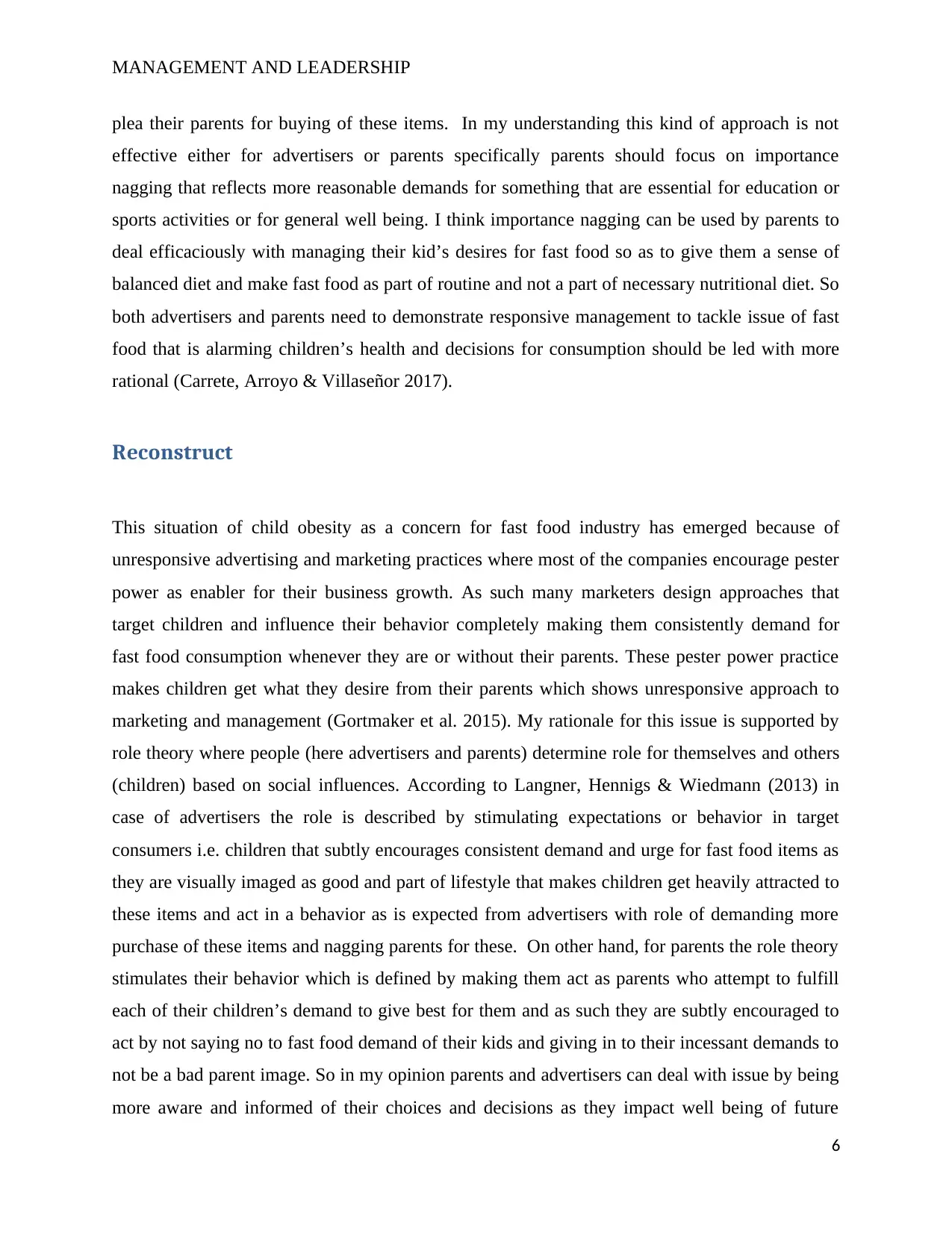
MANAGEMENT AND LEADERSHIP
plea their parents for buying of these items. In my understanding this kind of approach is not
effective either for advertisers or parents specifically parents should focus on importance
nagging that reflects more reasonable demands for something that are essential for education or
sports activities or for general well being. I think importance nagging can be used by parents to
deal efficaciously with managing their kid’s desires for fast food so as to give them a sense of
balanced diet and make fast food as part of routine and not a part of necessary nutritional diet. So
both advertisers and parents need to demonstrate responsive management to tackle issue of fast
food that is alarming children’s health and decisions for consumption should be led with more
rational (Carrete, Arroyo & Villaseñor 2017).
Reconstruct
This situation of child obesity as a concern for fast food industry has emerged because of
unresponsive advertising and marketing practices where most of the companies encourage pester
power as enabler for their business growth. As such many marketers design approaches that
target children and influence their behavior completely making them consistently demand for
fast food consumption whenever they are or without their parents. These pester power practice
makes children get what they desire from their parents which shows unresponsive approach to
marketing and management (Gortmaker et al. 2015). My rationale for this issue is supported by
role theory where people (here advertisers and parents) determine role for themselves and others
(children) based on social influences. According to Langner, Hennigs & Wiedmann (2013) in
case of advertisers the role is described by stimulating expectations or behavior in target
consumers i.e. children that subtly encourages consistent demand and urge for fast food items as
they are visually imaged as good and part of lifestyle that makes children get heavily attracted to
these items and act in a behavior as is expected from advertisers with role of demanding more
purchase of these items and nagging parents for these. On other hand, for parents the role theory
stimulates their behavior which is defined by making them act as parents who attempt to fulfill
each of their children’s demand to give best for them and as such they are subtly encouraged to
act by not saying no to fast food demand of their kids and giving in to their incessant demands to
not be a bad parent image. So in my opinion parents and advertisers can deal with issue by being
more aware and informed of their choices and decisions as they impact well being of future
6
plea their parents for buying of these items. In my understanding this kind of approach is not
effective either for advertisers or parents specifically parents should focus on importance
nagging that reflects more reasonable demands for something that are essential for education or
sports activities or for general well being. I think importance nagging can be used by parents to
deal efficaciously with managing their kid’s desires for fast food so as to give them a sense of
balanced diet and make fast food as part of routine and not a part of necessary nutritional diet. So
both advertisers and parents need to demonstrate responsive management to tackle issue of fast
food that is alarming children’s health and decisions for consumption should be led with more
rational (Carrete, Arroyo & Villaseñor 2017).
Reconstruct
This situation of child obesity as a concern for fast food industry has emerged because of
unresponsive advertising and marketing practices where most of the companies encourage pester
power as enabler for their business growth. As such many marketers design approaches that
target children and influence their behavior completely making them consistently demand for
fast food consumption whenever they are or without their parents. These pester power practice
makes children get what they desire from their parents which shows unresponsive approach to
marketing and management (Gortmaker et al. 2015). My rationale for this issue is supported by
role theory where people (here advertisers and parents) determine role for themselves and others
(children) based on social influences. According to Langner, Hennigs & Wiedmann (2013) in
case of advertisers the role is described by stimulating expectations or behavior in target
consumers i.e. children that subtly encourages consistent demand and urge for fast food items as
they are visually imaged as good and part of lifestyle that makes children get heavily attracted to
these items and act in a behavior as is expected from advertisers with role of demanding more
purchase of these items and nagging parents for these. On other hand, for parents the role theory
stimulates their behavior which is defined by making them act as parents who attempt to fulfill
each of their children’s demand to give best for them and as such they are subtly encouraged to
act by not saying no to fast food demand of their kids and giving in to their incessant demands to
not be a bad parent image. So in my opinion parents and advertisers can deal with issue by being
more aware and informed of their choices and decisions as they impact well being of future
6
⊘ This is a preview!⊘
Do you want full access?
Subscribe today to unlock all pages.

Trusted by 1+ million students worldwide
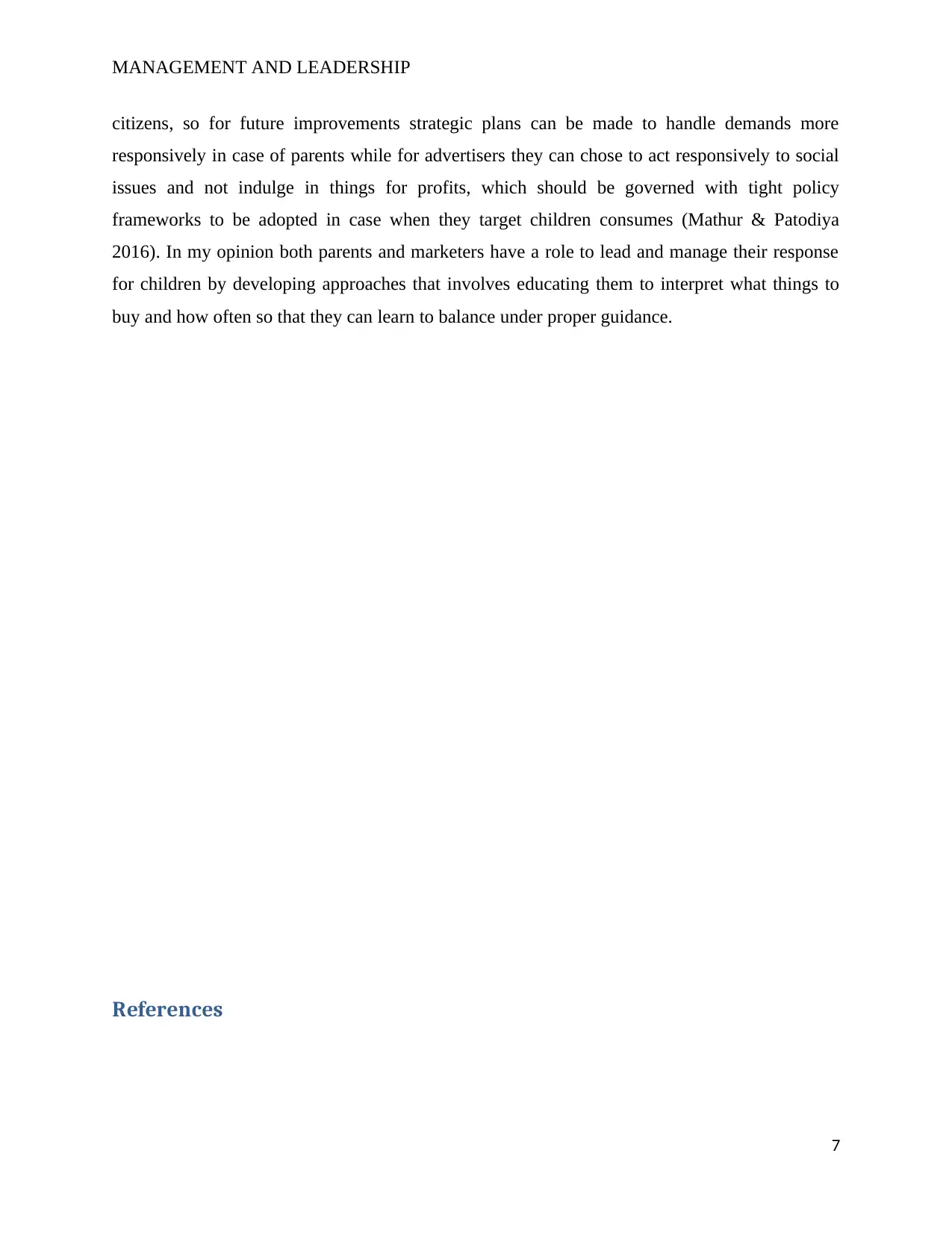
MANAGEMENT AND LEADERSHIP
citizens, so for future improvements strategic plans can be made to handle demands more
responsively in case of parents while for advertisers they can chose to act responsively to social
issues and not indulge in things for profits, which should be governed with tight policy
frameworks to be adopted in case when they target children consumes (Mathur & Patodiya
2016). In my opinion both parents and marketers have a role to lead and manage their response
for children by developing approaches that involves educating them to interpret what things to
buy and how often so that they can learn to balance under proper guidance.
References
7
citizens, so for future improvements strategic plans can be made to handle demands more
responsively in case of parents while for advertisers they can chose to act responsively to social
issues and not indulge in things for profits, which should be governed with tight policy
frameworks to be adopted in case when they target children consumes (Mathur & Patodiya
2016). In my opinion both parents and marketers have a role to lead and manage their response
for children by developing approaches that involves educating them to interpret what things to
buy and how often so that they can learn to balance under proper guidance.
References
7
Paraphrase This Document
Need a fresh take? Get an instant paraphrase of this document with our AI Paraphraser
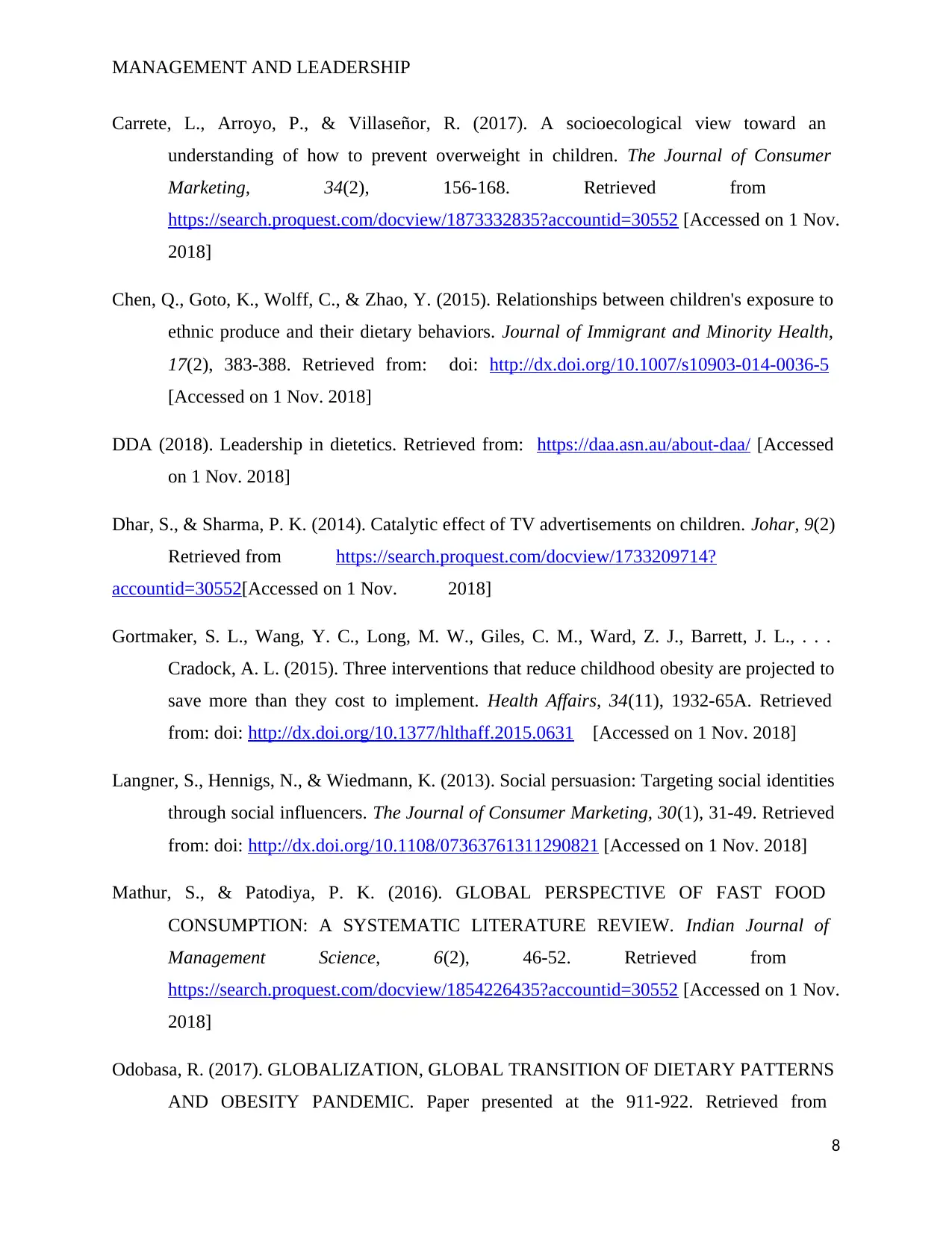
MANAGEMENT AND LEADERSHIP
Carrete, L., Arroyo, P., & Villaseñor, R. (2017). A socioecological view toward an
understanding of how to prevent overweight in children. The Journal of Consumer
Marketing, 34(2), 156-168. Retrieved from
https://search.proquest.com/docview/1873332835?accountid=30552 [Accessed on 1 Nov.
2018]
Chen, Q., Goto, K., Wolff, C., & Zhao, Y. (2015). Relationships between children's exposure to
ethnic produce and their dietary behaviors. Journal of Immigrant and Minority Health,
17(2), 383-388. Retrieved from: doi: http://dx.doi.org/10.1007/s10903-014-0036-5
[Accessed on 1 Nov. 2018]
DDA (2018). Leadership in dietetics. Retrieved from: https://daa.asn.au/about-daa/ [Accessed
on 1 Nov. 2018]
Dhar, S., & Sharma, P. K. (2014). Catalytic effect of TV advertisements on children. Johar, 9(2)
Retrieved from https://search.proquest.com/docview/1733209714?
accountid=30552[Accessed on 1 Nov. 2018]
Gortmaker, S. L., Wang, Y. C., Long, M. W., Giles, C. M., Ward, Z. J., Barrett, J. L., . . .
Cradock, A. L. (2015). Three interventions that reduce childhood obesity are projected to
save more than they cost to implement. Health Affairs, 34(11), 1932-65A. Retrieved
from: doi: http://dx.doi.org/10.1377/hlthaff.2015.0631 [Accessed on 1 Nov. 2018]
Langner, S., Hennigs, N., & Wiedmann, K. (2013). Social persuasion: Targeting social identities
through social influencers. The Journal of Consumer Marketing, 30(1), 31-49. Retrieved
from: doi: http://dx.doi.org/10.1108/07363761311290821 [Accessed on 1 Nov. 2018]
Mathur, S., & Patodiya, P. K. (2016). GLOBAL PERSPECTIVE OF FAST FOOD
CONSUMPTION: A SYSTEMATIC LITERATURE REVIEW. Indian Journal of
Management Science, 6(2), 46-52. Retrieved from
https://search.proquest.com/docview/1854226435?accountid=30552 [Accessed on 1 Nov.
2018]
Odobasa, R. (2017). GLOBALIZATION, GLOBAL TRANSITION OF DIETARY PATTERNS
AND OBESITY PANDEMIC. Paper presented at the 911-922. Retrieved from
8
Carrete, L., Arroyo, P., & Villaseñor, R. (2017). A socioecological view toward an
understanding of how to prevent overweight in children. The Journal of Consumer
Marketing, 34(2), 156-168. Retrieved from
https://search.proquest.com/docview/1873332835?accountid=30552 [Accessed on 1 Nov.
2018]
Chen, Q., Goto, K., Wolff, C., & Zhao, Y. (2015). Relationships between children's exposure to
ethnic produce and their dietary behaviors. Journal of Immigrant and Minority Health,
17(2), 383-388. Retrieved from: doi: http://dx.doi.org/10.1007/s10903-014-0036-5
[Accessed on 1 Nov. 2018]
DDA (2018). Leadership in dietetics. Retrieved from: https://daa.asn.au/about-daa/ [Accessed
on 1 Nov. 2018]
Dhar, S., & Sharma, P. K. (2014). Catalytic effect of TV advertisements on children. Johar, 9(2)
Retrieved from https://search.proquest.com/docview/1733209714?
accountid=30552[Accessed on 1 Nov. 2018]
Gortmaker, S. L., Wang, Y. C., Long, M. W., Giles, C. M., Ward, Z. J., Barrett, J. L., . . .
Cradock, A. L. (2015). Three interventions that reduce childhood obesity are projected to
save more than they cost to implement. Health Affairs, 34(11), 1932-65A. Retrieved
from: doi: http://dx.doi.org/10.1377/hlthaff.2015.0631 [Accessed on 1 Nov. 2018]
Langner, S., Hennigs, N., & Wiedmann, K. (2013). Social persuasion: Targeting social identities
through social influencers. The Journal of Consumer Marketing, 30(1), 31-49. Retrieved
from: doi: http://dx.doi.org/10.1108/07363761311290821 [Accessed on 1 Nov. 2018]
Mathur, S., & Patodiya, P. K. (2016). GLOBAL PERSPECTIVE OF FAST FOOD
CONSUMPTION: A SYSTEMATIC LITERATURE REVIEW. Indian Journal of
Management Science, 6(2), 46-52. Retrieved from
https://search.proquest.com/docview/1854226435?accountid=30552 [Accessed on 1 Nov.
2018]
Odobasa, R. (2017). GLOBALIZATION, GLOBAL TRANSITION OF DIETARY PATTERNS
AND OBESITY PANDEMIC. Paper presented at the 911-922. Retrieved from
8
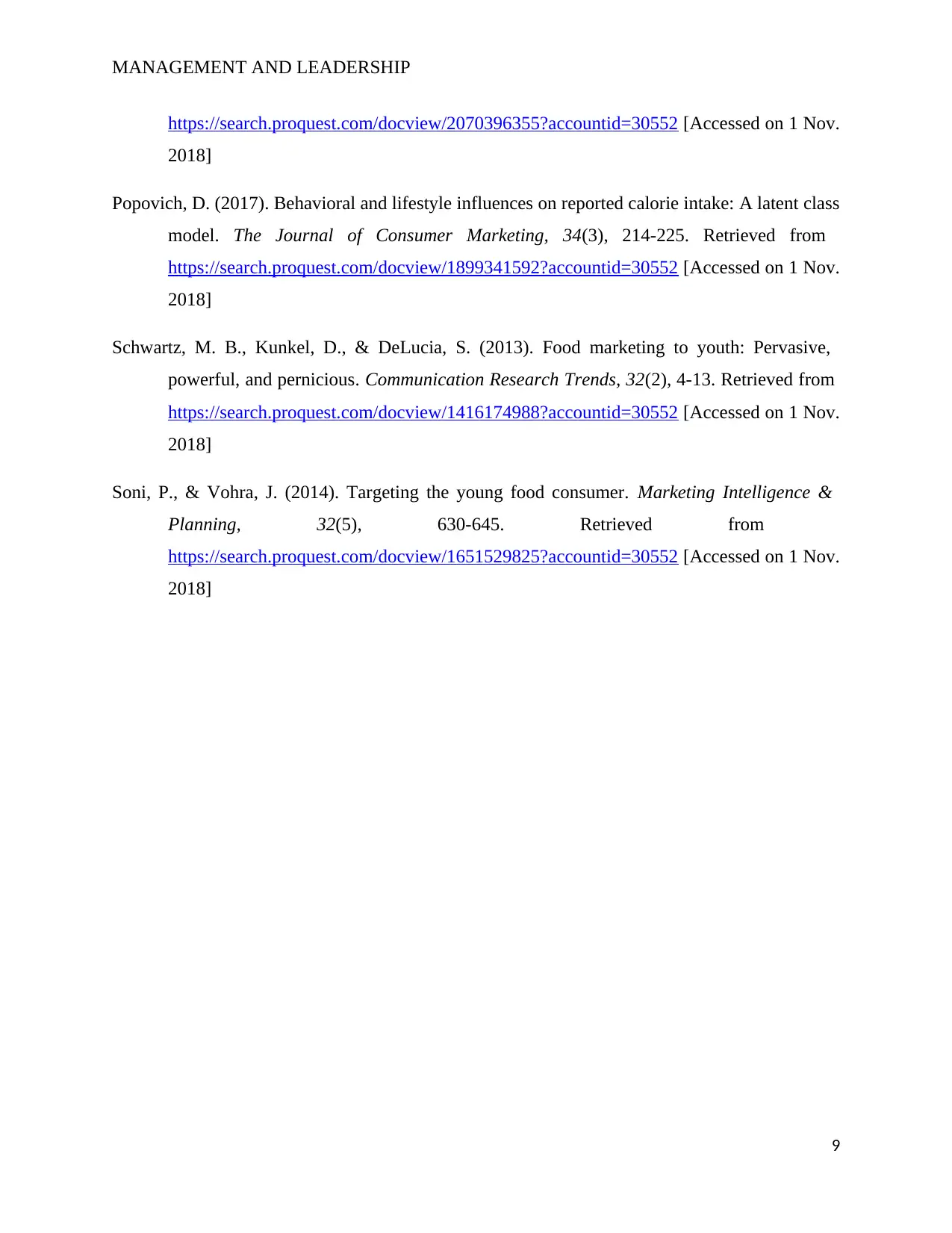
MANAGEMENT AND LEADERSHIP
https://search.proquest.com/docview/2070396355?accountid=30552 [Accessed on 1 Nov.
2018]
Popovich, D. (2017). Behavioral and lifestyle influences on reported calorie intake: A latent class
model. The Journal of Consumer Marketing, 34(3), 214-225. Retrieved from
https://search.proquest.com/docview/1899341592?accountid=30552 [Accessed on 1 Nov.
2018]
Schwartz, M. B., Kunkel, D., & DeLucia, S. (2013). Food marketing to youth: Pervasive,
powerful, and pernicious. Communication Research Trends, 32(2), 4-13. Retrieved from
https://search.proquest.com/docview/1416174988?accountid=30552 [Accessed on 1 Nov.
2018]
Soni, P., & Vohra, J. (2014). Targeting the young food consumer. Marketing Intelligence &
Planning, 32(5), 630-645. Retrieved from
https://search.proquest.com/docview/1651529825?accountid=30552 [Accessed on 1 Nov.
2018]
9
https://search.proquest.com/docview/2070396355?accountid=30552 [Accessed on 1 Nov.
2018]
Popovich, D. (2017). Behavioral and lifestyle influences on reported calorie intake: A latent class
model. The Journal of Consumer Marketing, 34(3), 214-225. Retrieved from
https://search.proquest.com/docview/1899341592?accountid=30552 [Accessed on 1 Nov.
2018]
Schwartz, M. B., Kunkel, D., & DeLucia, S. (2013). Food marketing to youth: Pervasive,
powerful, and pernicious. Communication Research Trends, 32(2), 4-13. Retrieved from
https://search.proquest.com/docview/1416174988?accountid=30552 [Accessed on 1 Nov.
2018]
Soni, P., & Vohra, J. (2014). Targeting the young food consumer. Marketing Intelligence &
Planning, 32(5), 630-645. Retrieved from
https://search.proquest.com/docview/1651529825?accountid=30552 [Accessed on 1 Nov.
2018]
9
⊘ This is a preview!⊘
Do you want full access?
Subscribe today to unlock all pages.

Trusted by 1+ million students worldwide
1 out of 9
Related Documents
Your All-in-One AI-Powered Toolkit for Academic Success.
+13062052269
info@desklib.com
Available 24*7 on WhatsApp / Email
![[object Object]](/_next/static/media/star-bottom.7253800d.svg)
Unlock your academic potential
Copyright © 2020–2025 A2Z Services. All Rights Reserved. Developed and managed by ZUCOL.




